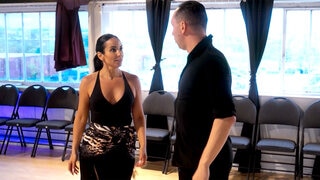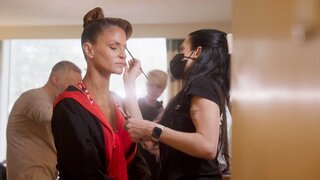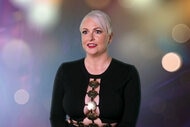
Create a free profile to get unlimited access to exclusive videos, sweepstakes, and more!
How Do You Find a Professional Partner for Ballroom Dancing? The Process, Explained
To spin, twirl, and promenade with the best of them in Pro-Am competitions, amateur dancers need to find a professional partner to take them out onto the dance floor. Here's how to do it.
With its glitz, glamor, and undeniably covetable dance moves, it’s easy to see why Dancing Queens might inspire even the most inexperienced dancer to want to lace up their own dance shoes and hit the ballroom.
But just how do amateur dancers find professional partners to lead them into the world of competitive ballroom dance?
Where Do You Find Pro-Am Partners for Ballroom Dance?
It turns out local dance studios are often a good place to start.
RELATED: Meet The Cast of Dancing Queens
“That’s where you’d go and it would take a lot of lessons to get to be good to compete with these people who have already been doing it,” Gary Spencer, who developed and manages the World Pro-Am DanceSport Series website recently told The Daily Dish.
According to Spencer, most of the professional dancers are also teachers or instructors at ballroom dance studios.
“That’s where all these teachers come from,” he said.
To be a pro, the dancers must be registered with the National Dance Council of America.
And to enter into the world of ballroom dance as an amateur competing with a professional partner doesn’t come cheap. A portion of each pro’s yearly income comes from training and competing with their amateur partners.

“For a professional partner, you have to pay their fee, their flights, their hotels,” Dancing Queens cast member Sabrina Strasser explained in the premiere. “It’s like a hired escort.”
Except these relationships typically aren’t romantic — they are centered on mastering the sport of ballroom dance.
“A lot of people want like a girlfriend experience, you know, like, ‘Oh, let’s go out to dinner’ and like, ‘Oh, let’s go see a show before the competition,’ but I’m paying for a dance partner, not a gigolo,” cast member Donie Burch said of the distinct difference.
Dancing With The Stars alum Cheryl Burke shared in a video on her YouTube channel explaining how as a young 11-year-old amateur she got her start in Pro-Am tournaments by partnering with those instructors affiliated with her dance studio.
“After taking my first few lessons, I decided that I wanted to compete and it was recommended by my instructor at the time to compete with him at first until I was good enough to find myself a dance partner and to compete with my teacher which is what Pro-Am is all about,” she said in a video on her YouTube channel explaining her dance roots. “It’s basically, you know, when a teacher competes and competes with their partner or student, which would have been me.”
Professional Christopher Pilarchik shared on a ballroom dance blog in 2015 that another way to find a partner is to attend the local ballroom competitions as a spectator and talk to the studio owners and judges — who are likely well-versed in who might be looking for a partnership.
“With a little ingenuity, you can find out who the various studio owners and judges are, introduce yourself and explain your dilemma,” he wrote. “It also gives you the possible chance of seeing the potential partner in action, and possibly meeting them to discern their worth.”
There are even some Facebook sites devoted exclusively to connecting those looking for partners.
Once you do find a partner to step onto the dance floor with, there won’t be a shortage of opportunities to show off your best spins, promenades, pivots, and side steps.
Each year, Spencer said there are more than 90 World ProAm DanceSport series events in North America, and as soon as one season ends, another begins.
“It’s a subculture to its own,” he said.



































